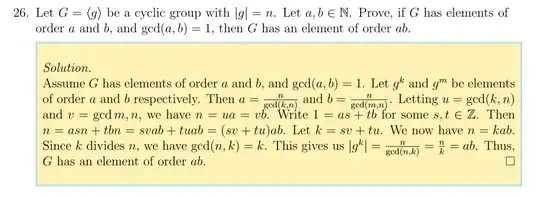By hypothesis, $\exists x,y \in G$ s.t. $|x|=a$, $|y|=b$ and $gcd(a,b)=1$.
Claim: $|xy| = ab$
$proof:$
Since $G$ is cyclic, it is abelian, and so $(xy)^{ab}=x^{ab}y^{ab}=(x^a)^b(y^b)^a=(e^b)(e^a)=(e)(e)=e$.
Therefore $ab$ divides $|xy|$.
Suppose that $\exists k \in \mathbb{N}$ such that $1<k<ab$ and $(xy)^k=e.$ Since $G$ is abelian we have $(xy)^k=x^ky^k=e$. Thus $x^k=y^{-k} \in \langle x \rangle \cap \langle y \rangle = \{e\}$ and so we have that $a|k$ and $b|k$, which then implies $k \geq lcm(a,b)=ab$, but this is a contradiction as we chose $k$ so that $1<k<ab$.
Thus we have showed that $(xy)^{ab}=e$ and that there is no number $1<k<ab$ such that $(xy)^k=e$. Thus the order of $xy$ is $ab$
